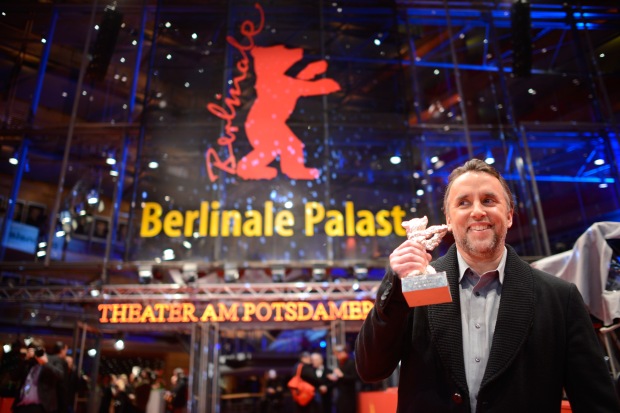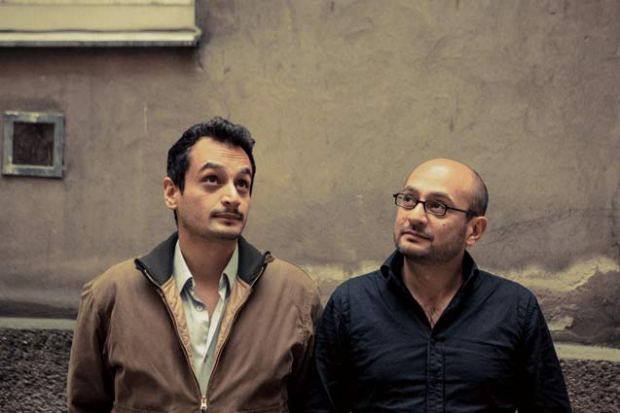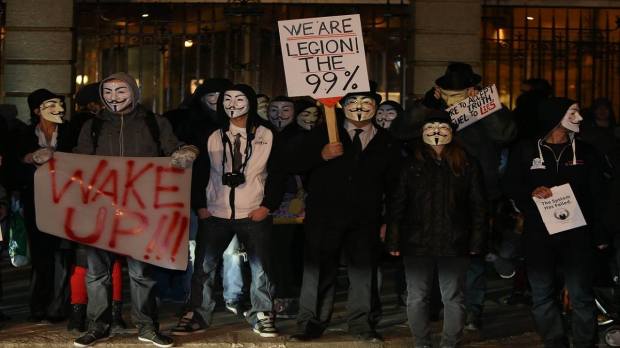
Winner of the best documentary on cinema at the Venice film festival 2013, Gabe Klinger’ debut documentary Double Play: James Benning and Richard Linklater offers a joint profile of two American filmmakers from different traditions and generations: the Austin-based indie pioneer Richard Linklater and the veteran avant-garde purist James Benning, whose self-produced films border on abstract visual art.
A low-budget debut feature completed with a Kickstarter fundraising campaign, Double Play was mostly shot over a single weekend in Texas. The film is a very perceptive, fresh portrait of two filmmakers and friends who have more in common than one would assume at first sight.
This interview was taken at the Danish Cinemateket in Copenhagen on November, 10, 2013, as part of CPH:DOX Documentary Film Festival.
Dana: What sparked this project and how did you approach Richard Linklater and James Benning?
Gabe: It happened really quickly, I didn’t fully realise until we were making it, it was never a calculation on my part that I would start making this film, it was just: “Oh, wait, now I’m doing this”. It was a project of 5 or 6 months, but then it just took over my life and for a little film like this one, we shot it in 4 days, it’s a tremendous amount of work because it’s not just 4 days, there’s postproduction, editing, working with all the archival material, it’s really finding the ideas…We recorded many many hours every day, we were working for 16 hours a day and you have all that material and you really need to find the subject of the movie, the ideas that are hidden in all that material, and that takes months. But to answer your question more specifically, it was an idea that I took to James and to Rick in Berlin, at the Berlin Film Festival this year (2013) and it was after the premiere of the film Before Midnight, we went to have a few drinks and as the night went on we had more drinks and then they went “Ok fine it’s a good idea”. And then I went to Paris a few days later and one of the producers on the film, Eugenio Renzi took me to see André S. Labarthe who is the co-founder of this legendary series called Cinéma de notre temps. It’s over 100 films now spanning about 50 years, documentaries about filmmakers, there’s even one on Dreyer that was made by Eric Rohmer, which is very good. So I wanted the film to be part of this series and I thought maybe if André accepted the film to be part of the series, we could get a bit of money to do it. So I asked Eugenio what kind of whiskey André liked and I bought him a bottle of Johnny Walker Black Label and I showed up at his doorstep. And the rest is history.
Dana: What was it like to balance two filmmakers that are so very different cinematically speaking?
Gabe: I think I’d already seen certain connections between them and their work when I started to think about them together. And the way that I discovered that they were friends was that a childhood friend of Benning’s showed me some footage that he had on his cell phone of James and Rick throwing a baseball, like the way they throw the baseball in the movie. And I was like: “Wow, these guys are friends, that’s amazing!” So that was the genesis of the idea. So I started to think about how their work might be similar. And I realised there were all these elements of time, of duration, of time passing, in Linklater, the way the time passes between his films, like the Before trilogy, which are all made at 9 year intervals. I’m of a certain generation where I saw Before Sunrise at a certain age when it came out, and I was another person when I saw Before Sunset. And when I saw Before Midnight in Berlin this year I’m yet another person, we keep growing and those characters in the movie, played by Juliette Delpy and Ethan Hawke, I don’t see them as movie characters, I see them as people in my life. And when I watch Benning, the same thing is sort of happening, it’s testing my idea of what cinema can be. And I remember watching a James Benning film when I was a teenager and thinking “This is awful, I hate it, I’m so bored right now”. I just wasn’t ready for James Benning. And then a few years later I went back, and it was this process of something awakening in my mind and I can’t really pinpoint the moment when that happened but it happens and then that’s it, you’re fucked for life! …You can’t talk to your parents anymore at the dinner table, your interests are too obscure and weird…
Dana: How did you go about deciding how much screen time to give each filmmaker?
Gabe: People usually say there’s not enough of Linklater, there’s more Benning. It’s a compromise, because you have to accept that the television format is a certain way and this is a film, 70 min long, and that one shot from in Thirteen Lakes that appears in the film, that shot lasts for 10 minutes. And you can’t put a 10min shot in a 70 min movie. Benning saw the film in Vienna a week ago and his observations were that he really liked it, he enjoyed it, he thought it captured the spirit of their friendship well but he said “It’s a good film and I told my students not to make good films”! So I thought, that’s great, it’s a good movie, it’s not a radical reinventing of the wheel of cinema, I kind of accepted certain limitations that were presented to me and tried to work within those. And some of the best comments I got are exactly about the length, people wanted to see more, or wanted to find out more about Benning. So if that’s an outcome of the experience, I think it’s a good one.
Dana: Was Linklater reluctant to show you clips from Boyhood?

Ellar Coltrane in Boyhood
Gabe: I don’t think he calculated fully in his head what the effect would be, if it’s a marketing opportunity, partly because none of them knew how the film would turn out, none of us did. I didn’t know if we were going to have a movie at all! But by the end of the first day’s shoot I thought, “Okay, we have a movie”. I think he thought it was going to be just me, with my camera and Rick and James, and Alexandra, and we’d be in the editing room, just the four of us maybe. But then there was the crew, we had two cameras, a couple of operators, camera assistants, sound guy, production assistant, my producer, myself. I hope you don’t notice it in the film but we had a big crew, we had about 10 people with us all the time. But the idea was to preserve this sort of intimacy and I think we were able to create that illusion quite well, but in the editing room sequence Rick was just like “Oh, this film I’ve been working on for the last 10 years…” So yes maybe he was a bit reluctant, and I can see why. Just to give you an idea: no movie studios would ever produce a project like that because contractually, legally, you can’t have a contract for more than 7 years. So that means if you cast Brad Pitt, you can only cast him for seven years. After that you have to renegociate the contract. That’s why the guys who make the Simpsons, they make a ton of money because every year they can renegociate their contract and they know that they need them, they need the voices of the Simpsons. So it’s like suicide for a big Hollywood production, in this case the Independent Film Channel who finances the movie, and they’ve been doing it for 12 years and there are different management teams that come in and they look in the books and they go “Oh, there’s this weird movie that we’ve been filming for 12 years, what is that?” And there always has to be someone who says “Oh, that’s ok, we’re still gonna finance that”. So it’s like a big battle and I think emotionally for him, for Linklater, that’s the big deal, that he’s been able to do that, it’s a big victory. So I think in that way he was a bit reluctant, and he is […] a sensitive guy. Like if you compare him to Tarantino. He’s very much that sensitive, introverted kind of guy […].
Dana: How much did you intervene in the filming?
Gabe: There was very little intervention that was necessary on my part. They made it very easy for me, although there were still decisions to be made about where to put the camera […]. The project was that I would let them take it where they wanted to take it. And they did, in this really beautiful way. There were certain scenes that we restaged for whatever reason. But those are secrets that are staying with the crew!
Dana: There was a scene in which Benning is in front of this big, impressive wall. The scene stands out stylistically, why did you put him there?
Gabe: Linklater had to go and put in his “dad time”, he has three young daughters. And Benning said “let’s just go and shoot some stuff”. So we just went off with Benning alone and we found this great wall that is the Lyndon B. Johnson Library at the University of Texas campus. It’s just this monolithic building, an incredible building. And Benning was very fascinated and drawn to it, he’d never seen it before. Or maybe he had and he forgot. And we just started walking around it, so I just said ” Give me the opportunity to be a real movie director, walk from here to here”. And we did it three times until we got it exactly right. But for me the meaning was to try to emulate a Benning film, to lose our own language and to try to appropriate Benning’s. It was me and my DP’s idea to stage that scene but Benning is always excited to act and the moment where that comes out the most is in the baseball scene where he falls down. I mean he fell down, legitimately, and he kind of hurt his leg, and the rest of the day he was limping… But I think he was also trying to have his Buster Keaton moment.

From left to right: James Benning, Richard Linklater, Gabe Klinger
Dana: Did they challenge you at all at any time, or did they question your decisions?
Gabe: I really only felt challenged by Benning […]. Linklater is used to being around a lot of people in a film crew, so he knows the dynamics of the set very well and how the set works, the hierarchy, the director is not exactly a dictator but he’s making the decisions…And sometimes Benning just wouldn’t accept my decisions. So in one sequence I wanted to do something and Benning said audibly in front of everyone that I was an idiot. Affectionately! And he won’t deny it. But then Linklater would come in in this really sweet way and say ” So Gabe, what do you want us to do now?” So Rick knew enough about Benning and he would behave in a way to protect me from Benning!
Dana: Have you considered being part of the frame and interacting with them or it was your initial intention to be behind the camera?
Gabe: There were two models for me for making this film, one was Jacques Rivette’s documentary about Jean Renoir and Michel Simon from 1966. And it’s just Michel Simon and Jean Renoir talking at a lunch table at a very busy Paris restaurant. And Henri Cartier Bresson and Rivette and a bunch of other people were in the room but you don’t really feel their presence, you feel that Simon and Renoir are having a moment. They were very good at kind of acting. So there’s an illusion that you are living this real moment sitting down to lunch with Renoir and Simon but really there’s the whole machine behind it, the filmmaking, and them being aware that they are putting up a show. So I think Linklater and Benning understood that we are putting up a show of sorts. And the second film was Jacques Rivette and Serge Daney made by Claire Denis, again we’re having two people, two for the price of one!
Dana: How challenging was it to make a documentary about two of your favourite filmmakers?
Gabe: It was very challenging for me because I admire them a lot. I know Benning very well, I’ve known him since…since I couldn’t drink legally and yet he’s a difficult guy in some ways to get close to and he’s a minimalist and doesn’t like a lot of attention sometimes. But then I told everybody in our crew to be really curious and when we had breaks or went out to lunch, all the young people in the crew would ask him about his life and his films. So he lit up, he felt loved and that made him open up to the experience. So that was a clever way to get them both to trust me more. And Rick is just… I mean anybody who has spent time in Austin, Texas has probably encountered Linklater and maybe even had a favor… He’s the nicest guy to approach, he’s very accessible, and he loves movies, and he’s genuine. So he probably recognised that my intention was a very serious one.

Director Richard Linklater poses with his Silver Bear for Best Director after the closing ceremony of the Berlinale February 15th, 2014. Linklater won for his film Boyhood.












